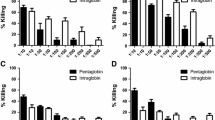Abstract
Immunoglobulin-G (IgG) subclass-specific antibody to cholera toxin andVibrio cholerae lipopolysaccharide in 26 individuals vaccinated withV. cholerae whole cells and procholeragenoid was investigated. An ELISA assay with monoclonal IgG subclass-specific antibodies was employed. The response to vaccination was found to be predominantly of the IgGl (100%) and IgG2 (73%) subclass. The magnitude of the IgG response was greater for the antitoxic compared with the antilipopolysaccharide vaccine component. IgG subclass antibodies evoked in response to immunization had no influence on the overall IgG subclass serum concentrations.
Similar content being viewed by others
Literature Cited
Aalberse RC, Van der Gaag R, Van Leeuwen J (1983) Serologic aspects of IgG4 antibodies I. Prolonged immunization results in an IgG4-restricted response J Immunol 130:722–726
Beck OE (1981) Distribution of virus antibody activity among human IgG subclasses. Clin Exp Immunol 43:626–632
Carrel S. Morell A, Skvaril F, Barandun S (1972) Human tetanus antibodies: isolation and characterization with special reference to the IgG subclasses. FEBS Lett 19:305–307
Craig JP (1971) Choleratoxins In: Kadis S, Montie TC, Ajl SJ (eds) Microbial toxins, vol II A. New York: Academic Press, pp 189–254
Finkelstein RA (1962) Vibriocidal antibody inhibition (VAI) analysis: a technique for the identification of the predominant vibriocidal antibodies in serum and for the detection and identification ofVibrio cholerae antigens. J Immunol 89:264–271
Finkelstein RA, Fujita K, Lospalluto JJ (1971) Procholeragenoid: an aggregated intermediate in the formation of choleragenoid. J Immunol 107:1043–1051
Freijd A, Hammerström L, Persson AA, Smith CIE (1984) Plasma anti-pneumococcal antibody activity of the IgG class and subclasses in otitis prone children. Clin Exp Immunol 56:233–238
Fürer E, Cryz SJ Jr, Dorner F, Nicolet J, Wanner M, Germanier R (1982) Protection against colibacillosis in neonatal piglets by immunization of Dams with procholeragenoid. Infect Immun 35:887–894
Fürer E, Cryz SJ Jr, Germanier R (1983) Protection of piglets against colibacillose based on antitoxic immunity. Dev Biol Stand 53:161–167
Germanier R, Fürer E, Varallyay S, Inderbitzin TM (1976) Preparation of a purified antigenic cholera toxoid. Infect Immun 13:1692–1698
Germanier R, Fürer E, Varallyay S, Inderbitzin TM (1977) Antigenicity of cholera toxoid in humans. J. Infect Dis 135:512–516
Van der Giessen M, Groeneboer-Kempers O (1976) The subclasses of human IgG antibodies against tetanus toxoid. Clin Exp Immunol 25:117–121
Hammerström L, Granström M, Oxelius M, Persson AA, Smith CIE (1984) IgG subclass distribution of antibodies againstS. aureus teichoic acid and α-toxin in normal and immunodeficient donors. Clin Exp Immunol 55:593–601
Holmgren J, Svennerholm AM (1973) Enzyme-linked immunosorbent assay for cholera serology. Infect Immun 7:759–763
Kessler SW (1975) Rapid isolation of antigens from cells with a staphylococal protein A-antibody adsorbed: parameters of the interaction of antibody-antigen complexes with protein A. J Immunol 115:1617–1624
Morell A, Roth-Wicky B, and Skvaril F (1983). IgG subclass restriction of antibodies against hepatitis B surface antigen. Infect Immun 39:565–568
Perelmutter L (1983) IgG4 and the immune system. Clin Rev Allerg 1:267–287
Skvaril F (1983) Human IgG subclasses in antiviral antibodies determined with monoclonal antibodies in ELISA. In: Avrameas S (ed) Immunoenzymatic techniques. Amsterdam: Elsevier, pp 287–290
Skvaril F, Joller-Jemelka H (1984) IgG subclasses of anti-HBs antibodies in vaccinated and in non-vaccinated individuals and in anti-HBs immunoglobulin preparations. Int Arch Allerg 73:330–337
Skvaril F, Roth-Wicky B, Barandun S (1980) IgG subclasses in human gamma globulin preparations for intravenous use and their reactivity withStaphylococcus, protein A. Vox Sang 38:147–155
Skvaril F, Schilt U (1984) Characterization of the subclasses and light chain types of IgG antibodies to rubella. Clin Exp Immunol 55:671–676
Westphal O, Lüderitz O, Bister F (1952) Ueber die Extraktion von Bakterien mit Phenol-Wasser. Z Naturforsch 7:148–155
Yount WJ (1975) Imbalances of IgG subclasses and gene defects in patients with primary hypogammaglobulinemia. In: Bergsma D (ed) Immunodeficiency in man and animals. Sunderland MA: Sinauer Associates, pp 99–107
Author information
Authors and Affiliations
Rights and permissions
About this article
Cite this article
Skvaril, F., Cryz, S.J. & Fürer, E. Human immunoglobulin-G subclass distribution in response to vaccination withVibria cholerae vaccine and procholeragenoid. Current Microbiology 12, 147–150 (1985). https://doi.org/10.1007/BF01567667
Issue Date:
DOI: https://doi.org/10.1007/BF01567667




